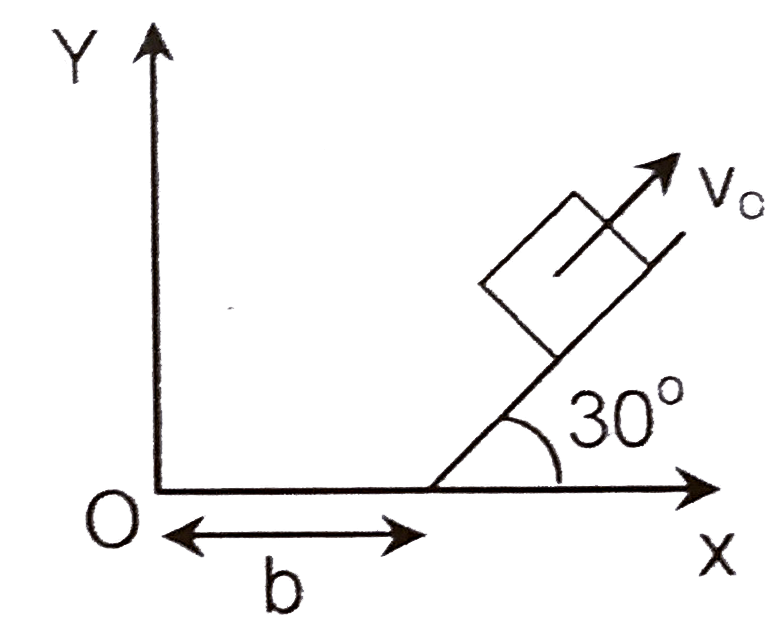A uniform cube with edge a rests on a horizontal plane whose friction coefficient equals k. The cube is set in motion with an intial velocity, travels some distance over the plane and comes to a stand still. Explain the disappearance of the angular momentum of the cube relative to the axis lying in the plane at right angles to the cube's motion direction. Find the distance between the resultants of gravitational forces and the reaction forces exerted by the supporting plane.
When the cube is given an initial velocity on the table in some direction (as shown) it acquires an angular momentum about an axis on the table perpendicular to the initial velocity and (say) just below the C.G. This angular momentum will dissappear when the cube stops and this can only by due to a torque. Frictional forces cannot do this by themselves because they act in the plain containing the axis. But if the force of normal reaction act eccentrically (as shown), their torque can bring about the vanishing of the angular momentum. We can calculate the distance Δx between the point of application of the normal reaction and the C.G. of the cube as follows. Take the moment about C.G. of all the forces. This must vanish because the cube does not turn or turnble on the table.
Then if the force of friction is fr
fra2=NΔx
But N=mg and fr=kmg, so
Δx=ka/2

Topper's Solved these Questions
- PHYSICAL FUNDAMENTALS OF MECHANICSBook:IE IRODOV, LA SENA & SS KROTOVChapter:PHYSICAL FUNDAMENTALS OF MECHANICSExercise:Elastic Deformation Of Asolid Body
Explore 25 Videos
- PHYSICAL FUNDAMENTALS OF MECHANICSBook:IE IRODOV, LA SENA & SS KROTOVChapter:PHYSICAL FUNDAMENTALS OF MECHANICSExercise:Hydrodynamics
Explore 25 Videos
- PHYSICAL FUNDAMENTALS OF MECHANICSBook:IE IRODOV, LA SENA & SS KROTOVChapter:PHYSICAL FUNDAMENTALS OF MECHANICSExercise:Universal Gravitation
Explore 34 Videos
- OSCILLATIONS AND WAVESBook:IE IRODOV, LA SENA & SS KROTOVChapter:OSCILLATIONS AND WAVESExercise:Electromagnetic Waves, Radiation
Explore 36 Videos
- THERMODYNAMICS AND MOLECULAR PHYSICSBook:IE IRODOV, LA SENA & SS KROTOVChapter:THERMODYNAMICS AND MOLECULAR PHYSICSExercise:Transport Phenomena
Explore 38 Videos
Similar Questions
Knowledge Check
A uniform cube of mass m and edge a moves on a horizontal surface along the positive x-axis, with initial velocity v0. Then
ADuring motion , NgtmgBDuring motion, normal reactions acts on the center of massCduring motion, the normal reaction shifts towards positive x-axis from the center of massDduring motion, normal reaction shifts in the direction of the force of friction.The angle between the diagonal of a cube and an edge of the cube intersecting the diagonal, is
Acos−1(13)Bcos−1(√23)Ctan−1(√2)Dnone of theseThe length of edge of a cube is a, then shortest distance between the diagonal of cube and an edge skew to it is
Aa√2Ba/√2C√2/aDNone
A cube of edge a is placed at some distance from a long plane sheet of charge having surface density σ. Find the electric energy stored in the cube.
View SolutionA cube of weight 10N rests on a rough inclined plane of slope 3 in 5. The coefficient of friction is 0.6. The minimum force necessary to start the cube moving up the plane is
View SolutionA plane srface is inclined at an angle θ. A cube slides down the plane and a solid sphere rolls down the plane without slipping. The ratio of the acceleration of the cube to that of the sphere is
View SolutionA cube of mass m and side a is moving along a plane with constant speed vo as shown in figure. The magnitude of angular momentum of the cube about z -axis would be.

View SolutionMinimum distance between two tetrahedral voids if a is the edge length of the cube is
View Solution

